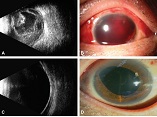Accuracy of Point of Care Ultrasound in Assessment of Traumatic Eye Injuries
DOI:
https://doi.org/10.31661/gmj.v14i.3635Keywords:
Eye; Trauma; Point of Care Ultrasound (POCUS); AccuracyAbstract
Background: A few studies have been conducted to assess the accuracy of point of care ultrasound in traumatic eye injuries. In the present study we aimed to examine the diagnostic value of Point of Care Ultrasound to assess eye injuries resulting from trauma. Materials and Methods: This observational study was performed on 221 consecutive patients with ocular trauma who admitted to emergency department of two teaching hospitals in 2016. On admission, all patients underwent ocular bedside ultrasonography to reveal ocular defects resulting from trauma. The diagnostic results of Point of Care Ultrasound were compared to the findings of clinical assessment of ophthalmologist as the gold standard. Results: Overalls, 13 lesions (5.9%) were revealed as ocular pathological lesions following trauma including retinal detachment in 6 cases, foreign body in 6 cases, and vitreous hemorrhage in one case. In this regard, Point of Care Ultrasound has a sensitivity of 86.7%, specificity of 94.7%, positive predictive value of 54.2%, negative predictive value of 98.9%, and an accuracy of 94.1%. The agreement coefficient between ultrasound and expert clinical assessment was 0.64 indicating an acceptable degree of agreement. (P<0.001). Conclusion: Along with clinical assessment, Point of Care Ultrasonography of eye can accurately assess traumatic eye lesions.
References
Loporchio D, Mukkamala L, Gorukanti K, Zarbin M, Langer P, Bhagat N. Intraocular foreign bodies: a review. Surv Ophthalmol. 2016;61(5):582-96.
https://doi.org/10.1016/j.survophthal.2016.03.005
PMid:26994871
Dastevska-Djosevska E. Ultrasonography in ocular trauma. hypothesis. 2013;12:13.
Sawyer MNA. Ultrasound imaging of penetrating ocular trauma. JEM J Emerg Med. 2009;36(2):181-2.
https://doi.org/10.1016/j.jemermed.2007.04.005
PMid:17976814
Mundt Jr GH, Hughes Jr WF. Ultrasonics in ocular diagnosis. Am J Ophthalmol. 1956;41(3):488-98.
https://doi.org/10.1016/0002-9394(56)91262-4
PMid:13302351
BAUM G, GREENWOOD I. The application of ultrasonic locating techniques to ophthalmology: Ultrasonic slit lamp in the ultrasonic visualization of soft tissues. AMA Arch Ophthalmol. 1958;60(2):263-79.
https://doi.org/10.1001/archopht.1958.00940080279015
PMid:13558798
Bedi DG, Gombos DS, Ng CS, Singh S. Sonography of the eye. AJR Am J Roentgenol. 2006;187(4):1061-72.
https://doi.org/10.2214/AJR.04.1842
PMid:16985158
Puodžiuvienė E, Paunksnis A, Kurapkienė S, Imbrasienė D. Ultrasound value in diagnosis, management and prognosis of severe eye injuries. Ultrasound. 2005;56(3):40-3.
Sharma O. Orbital sonography with it's clinico-surgical correlation. Indian Journal of Radiology and Imaging. 2005 Oct 1;15(4):NA.
https://doi.org/10.4103/0971-3026.28792
Nzeh D, Owoeye J, Ademola-Popoola D, Uyanne I. Correlation of clinical and ultrasound findings in orbito-ocular disease using non-dedicated scanners: Experience at Ilorin. Nigeria Eur J Res. 2007;16(3):352-7.
https://doi.org/10.1177/112067210601600315
PMid:16761249
Nagaraju RM, Gurushankar G, Kadakola B. Efficacy of high frequency ultrasound in localization and characterization of orbital lesions. Journal of clinical and diagnostic research: JCDR. 2015;9(9):TC01.
https://doi.org/10.7860/JCDR/2015/13021.6428
PMid:26500977 PMCid:PMC4606306
Fasasi MK, Salihu MH. Importance of ultr asonography in e valuating eye injuries: data from Birnin K ebbi, N igeria. SSMJ. 2018;11(3):65-7.
Fielding J. The assessment of ocular injury by ultrasound. Clin Radiol. 2004;59(4):301-12.
https://doi.org/10.1016/j.crad.2003.10.010
PMid:15041449
Haghighi SHO, Begi HRM, Sorkhabi R, Tarzamani MK, Zonouz GK, Mikaeilpour A, et al. Diagnostic accuracy of ultrasound in detection of traumatic lens dislocation. Emergency. 2014;2(3):121.
Vrablik ME, Snead GR, Minnigan HJ, Kirschner JM, Emmett TW, Seupaul RA. The diagnostic accuracy of bedside ocular ultrasonography for the diagnosis of retinal detachment: a systematic review and meta-analysis. Ann Emerg Med. 2015 Feb 1;65(2):199-203.
https://doi.org/10.1016/j.annemergmed.2014.02.020
PMid:24680547
Zvornicanin J, Jusufovic V, Cabric E, Musanovic Z, Zvornicanin E, Popovic-Beganovic A. Significance of ultrasonography in evaluation of vitreo-retinal pathologies. Med Arch. 2012;66(5):318-20.
https://doi.org/10.5455/medarh.2012.66.318-320
PMid:23097969

Published
How to Cite
Issue
Section
License
Copyright (c) 2025 Galen Medical Journal

This work is licensed under a Creative Commons Attribution 4.0 International License.







